|
Background
By the mid nineteen thirties
Wolverhampton desperately needed a suitable music venue with
good acoustics and comfortable seating for large audiences.
At the time there were three buildings in the town where
concerts could be held; the Agricultural Hall, the Baths
Assembly Hall, and the Drill Hall, none of which was built
with concerts in mind. They all suffered from terrible
acoustics as can be seen from the following contemporary
descriptions:
Sir Henry Wood said that to give a
concert in the Agricultural Hall was “like performing in
a railway station.”
Mr. A. J. Sheldon, music critic
of the Birmingham Post described the Drill Hall as “Wolverhampton’s
sorry substitute for a concert building. He also stated that
“Its acoustics are not only bad, they are inconsistent. A
little way past the centre of the floor the orchestra and
chorus sound as if a gentle dispute were in progress a few
miles off. To one seated on the tavern-like benches at the
rear of the place, the volume of sound, though fuller, is
completely distorted. If Mr. Joseph Lewis, who conducted
last night, has any regard for his personal reputation. He
will not again seek any critical appreciation of such a work
when its performance is possible only under such wretched
conditions.”
He summarised his feelings for the
building as follows:
“Wolverhampton may possess a capable
fire brigade, yet if ever the Drill Hall of the town should
become ablaze the imagination can visualise the musical
enthusiasts of the city making a united stand against the
passage of anybody attempting to save the building.”
“The Wolverhampton Drill Hall would
serve admirably the purpose for which it was designed; as a
concert room however, it is an atrocity. It is even chillier
to begin with, than the Birmingham Town Hall has been since
it was reopened to the public. An additional diversion is a
still chillier draught which blows down the centre of the
room while a concert is in progress. Doors are banged
unmercifully while the music is going on, and when a
particularly soft bit of playing is entered on, noises come
from the back of the hall which suggest a well patronised
canteen not far away.” |
|
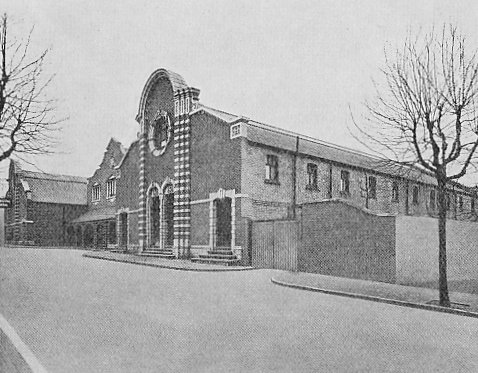
The public baths. |
The Baths Assembly Hall in the boarded-over swimming
pool was similarly draughty. As well as bad acoustics it had
a bare and naturally bath-like appearance, with a canopy of
iron girders. The lack of a suitable venue for concerts
was a serious problem for local orchestral and operatic
societies. Many of them ceased to exist because of the lack
of a suitable place to perform. One of the casualties was
the Wolverhampton Musical Society.
The reasons for its demise were listed in an article in
the Express & Star by Mr. E. M. Purkis entitled “An Inquest
on Wolverhampton Music.” |
|
An Inquest on Wolverhampton
Music
What are the reasons which have brought
this splendid society to an end? Broadcasting is blamed for
affecting the attendances, but many of those who have
followed the society's career are satisfied that the lack of
a suitable concert hall is what has actually killed it.
Every time the Musical Society gave a concert in the Drill
Hall it cost them nearly £40 as a minimum, and up to £60 in
the early years, for the hire of the hall, hire of chairs,
erection and taking down of platform, extra light and
cleaning….. Roughly the Musical Society have dropped in
their career not less than £650 through the lack of a public
hall. Their deficit when they reached their financial crisis
early last year was about half that, which seems to show
that the hall difficulty has meant the difference between a
handsome balance in hand and a crushing deficit. The lack of
a hall has also been a severe handicap in other ways.
The Drill Hall serves excellently the
purpose for which it was built, but it was never built for a
concert hall. It is cold and draughty. There are no
cloakroom facilities.
The concert patron had to listen seated
upon a small uncomfortable chair, usually hedged-in like the
proverbial sardine, and with coats, hats and umbrellas
packed all around him. Little wonder if many preferred to
listen to broadcast music in the comfort of their own homes.
There is no doubt whatever that the uncomfortable conditions
kept many people away and had their part in gradually
reducing the audiences.
The same drawbacks were felt to
some extent at the Baths Assembly Room, which,
however, is not really large enough for concerts run
on the scale of the Musical Society. Other reasons
have no doubt operated against Wolverhampton Choral
Society, which has also suspended operations, but a
good hall would have given them, too, a better
chance, and any organisation which seeks to provide
concerts on a large scale in Wolverhampton comes up
against the same difficulty.
As most people are aware, the
Wolverhampton Corporation have a site for a public
hall adjoining the Town Hall. Upon it stands the
telephone exchange, and until that is replaced by a
new exchange elsewhere which the postal authorities
have in view, that site will not be available. Plans
for the new exchange are at the moment passing
through the necessary channels for adoption, a slow
process with government departments. The contracted
date for giving-up the site for the Corporation is
May, 1932. Add two years to that for the erection of
a public hall and we have about five years to wait
before we can have any hope of the hall being ready
for use. The final moral of the Musical Society's
decision to close down, however, is most certainly
that Wolverhampton cannot hope to stage big concerts
again without great trouble and anxiety, if at all,
until it has secured that public hall which will
mean so much to its culture and social well-being.
|
|
|
Planning
a new public hall
For many years people talked about the
possibility of building a civic hall, but nothing happened
until 1920 when Councillor Clement Jenks raised the matter
at a council meeting. It took another two years for the
council to seriously consider the project.
In August 1922 the General Purposes
Committee was asked to recommend seven of its members to
form a Civic Hall Committee to consider, and report on the
desirability of building a hall out of the rates, and if so,
what form it should take, and where it would be built.
Word of the formation of the committee soon got around and
great public interest was shown in the project. It was aided
by the Express & Star which published articles and letters
about the project, and also ran a competition to decide on
the most desirable facilities that a public hall should
have.
The competition was won by two people who shared the
prize. Thanks to the newspaper’s influence, most of their
suggestions were eventually incorporated into the new
building. The competition and the articles in the newspaper
greatly increased public interest in the project, and
stirred the council into action. |
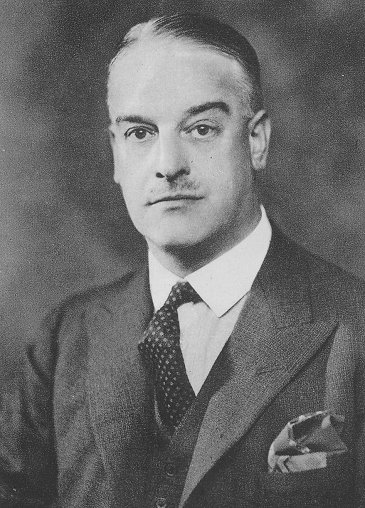
Councillor Bertram Kidson, J.P.
Chairman of the Civic Hall Committee. |
| In July 1924 the council decided to adopt the
committee’s recommendations after a debate that lasted three
hours, and a vote which was won by 19 to 16 votes. It was
estimated that the hall would cost around £80,000 which
equated to a two penny rate. On the following day the
Express & Star wrote: |
| The civic life of the town will unquestionably
be enhanced when a suitable hall has been completed.
Those who today are possibly feeling somewhat timid
will, we are sure, eventually realise the necessity
for a forward step and the wisdom of the decision,
though this was reached by a small majority of the
council. |
|
|
Although it seemed that the project
would soon get underway, there were still many delays which
lasted over ten years. In August 1925 the council launched
an improvement scheme to clear a site in readiness for the
building of the hall, but little else happened until
February 1934 when the Civic Hall Committee asked the
council to proceed as soon as possible with the scheme, and
organise an open architectural competition for the design.
The council agreed to the
recommendation, and two months later the committee produced
a second report which suggested that the hall should be used
for banquets, concerts, dances, meetings, and receptions. It
should cost no more than £100,000 plus an allowance of
£10,000 for contingencies, and fluctuations in the price of
materials and labour. Prizes of £350, £250, and £150 were
offered for designs.
There were still further difficulties.
By 1935 the estimated cost of the hall had increased to
£150,000. The council made an application to borrow the
money which was considered at an inquiry run by the Ministry
of Health. The Wolverhampton Property Owners’ Defence League
opposed the plan, and suggested that it should be postponed
for five years, but the Minister approved the plan and
building work began in April 1936. |
|
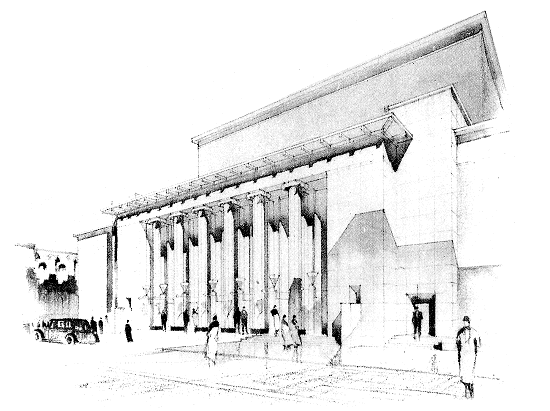
The proposed Civic Hall. |
The competition for the design was won by E. D. Lyons
and L. Isreal, A.A.R.I.B.A. of Ilford in Essex.
There were 122 entries from all parts of the country
which were examined by the eminent architect Mr. Cowles
Voysey who said of the winning design:
“It is an excellent scheme which I feel sure will
produce a very satisfactory building.” |
|
The new
Hall
As building work progressed, it was
supervised by the Civic Hall Committee, which in 1938 had the following
members:
| Councillor Bertram Kidson,
J.P. Chairman |
Councillor R. E. Probert.
Mayor of Wolverhampton |
| Alderman Sir Charles A.
Mander, Bt., D.L., J.P. Deputy
Mayor |
| Alderman M. Christopher,
J.P. |
Alderman W. Rooker |
| Alderman J. Clark, J.P. |
Alderman J. Whittaker, J.P. |
| Alderman M. H. Costley |
Councillor H. Bowdler |
| Alderman A. Davies, J.P. |
Councillor G. Luce |
| Alderman T. Frost, J.P. |
Councillor T. W. Simpson |
| Alderman J. Haddock |
Councillor F. W. Smithies |
| Alderman J. F. Myatt, J.P. |
|
Councillor Bertram Kidson, a chartered
accountant, and mayor of Wolverhampton in
1933/34 had been chairman since the
committee was formed. |
|
| The building, built of local multi-coloured
brick with Portland stone dressings, took around two
years to complete. It was built by a local firm,
Henry Willcock & Company Limited.
An early view of the
building. |
 |
|
The
contractors were as follows: |
| Henry Willcock & Company
Limited. Builders |
Rubery Owen & Company Ltd.
Structural steelwork |
| Henry Vale & Sons. Quantity
surveyors |
S. H. White & Son.
Consulting structural engineers |
| G. Stinton Jones and
Partners. Consulting engineers |
J. Gilbert Mills. Organ
consultant |
| J. R. Newton. Clerk of works |
Shaw’s Glazed Brick Co. Ltd.
External glazed ceramics |
| Troughton &
Young Limited. Electrical work |
Manley &
Regulus Ltd. Mechanical services, heating
and ventilation |
| W. Wadsworth Limited. Lifts |
Waygood-Otis Limited.
Hand-power lifts |
| Horseley Smith
& Company Limited. Dance floor |
James Gibbons
Limited. Metal windows, doors, and
ironmongery |
| Baldwins (Birmingham)
Limited. Sanitary fittings |
Potter Rax Limited.
Shutters |
| Gimson & Company (Leicester)
Limited. Stage equipment |
Haywards Limited. Saucer
lights in the cloakrooms |
| Tentest Fibre Board Company
Limited. Wall boarding |
Henry Miller Limited. Chair
lifts |
| Carron Company Ltd.
Staircases and kitchen equipment |
Art Pavements Limited.
Terrazzo floors |
| Fenning &
Company Limited. Marble panelling |
H. H. Martyn &
Company Ltd. Handrails, balustrading,
grilles, etc. |
| Starkie Gardner
& Company Ltd. Screens and cloakroom
fittings |
James Walker
Limited. Fibrous plaster |
| Furse & Company
Limited. Curtain tracks, steel shutters,
projection room etc. |
Carter &
Company. Decorative tiling |
| Charles Hunter. Dunlop
rubber flooring |
Eric Munday. Lettering,
motifs, etc. |
| G. H. Turner & Company.
Light fittings |
John Compton Organ Company.
Organ |
| James Clark & Sons. Mirrors |
Stourbridge Glazed Brick
Company Limited. Wall tiling |
| W. Beddows &
Company Limited. Flush doors |
Rivers-Moore
Radio Limited. Public address equipment and
deaf aid system |
| PEL Limited.
Chairs |
Kinematograph
Equipment Company Ltd. Projection room
equipment, carpets and stage equipment |
| Braby & Company. Ventilators |
Heal & Son Limited.
Furniture |
| Marion Dorn Limited and
Peter Jones. Curtains |
Kingfisher Limited. Chairs
for the orchestra |
| John Lewis & Company
Limited. Linoleum |
W. Smith & Company Limited.
Carpet druggets |
| J. Avery & Company. Blinds |
|
|
|
| A description of the
building in its original form |
|

The Civic Hall. |
There are two main assembly halls, the
larger Civic Hall and the smaller Wulfrun Hall, each forming
an independent unit with separate entrances and cloakrooms,
but for important functions they can be used as a suite of
rooms with a centrally-placed refreshment room and crush
room.
The entrance leads into a large
vestibule extending across the full width of the building,
with an open gallery on three sides, and large doors leading
into the Civic hall.
|
| The hall seats 1,283 people on the ground floor, and 497
in the gallery. A lower platform has space for an 80 piece
orchestra, with tiers behind, for a choir of up to 200.
The hall is completely encircled by promenades at both
ground and balcony levels. The colour scheme is grey,
primrose and fawn, with striped decorations, and oyster
coloured glass in the ceiling through which light filters.
The platform is flanked by silvered walls, and the
upholstery and carpets are a rich dark brown. |
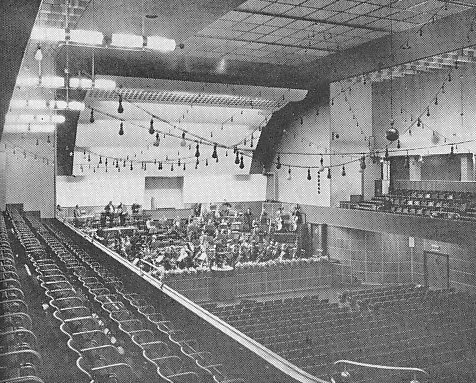
The Civic Hall during a rehearsal by
the Hallé Orchestra. |
|
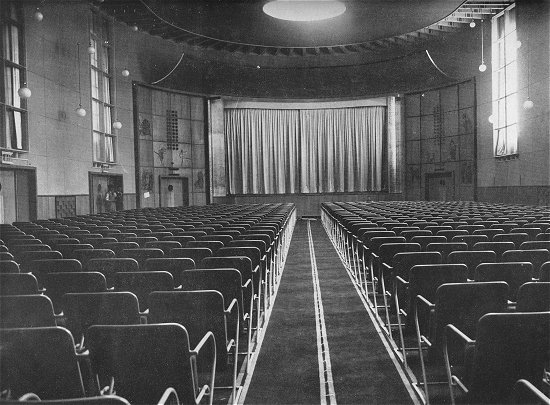
The Wulfrun Hall. |
The Compton organ has over 5,500 pipes,
and an electronic unit which provides many solo tones, and
carillon and bell effects.
The console has four manuals, sixty one
notes, and a concave pedal board with thirty two notes.
The Wulfrun Hall has a seating capacity
of 700 with walls covered with acoustic boards, and red
ceiling beams and door panels.
|
| On each side of the proscenium opening are murals
depicting the civic and social life of the town. They were
produced by Muriel Gilbert, a young artist who was
responsible for many of the paintings on the R.M.S. Queen
Mary. Both halls are equipped with cinema projectors,
naturally sprung dance floors, and a public address system.
There is ample accommodation for visiting artists on the
upper floors and under the stage of the Wulfrun Hall.
There is a large, well-equipped kitchen which can supply
anything from light refreshments to a banquet for 500.
There is a fully backed-up air-conditioning plant for
both halls with viscous oil filters to purify, wash, and
heat the air as required.
Great consideration was given to the acoustics in both
halls. One of the leading experts in the field, Mr. Hope
Bagenal, A.R.I.B.A. advised on the installation. |
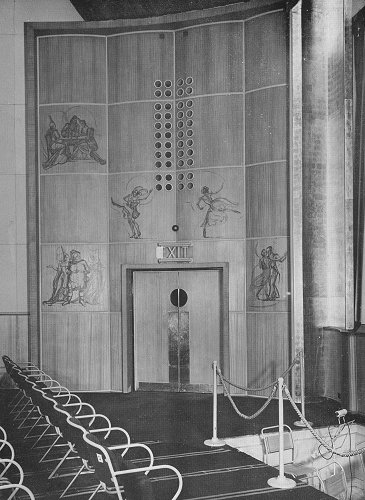
The murals in the Wulfrun hall. |
| The official opening and
the early years |
|
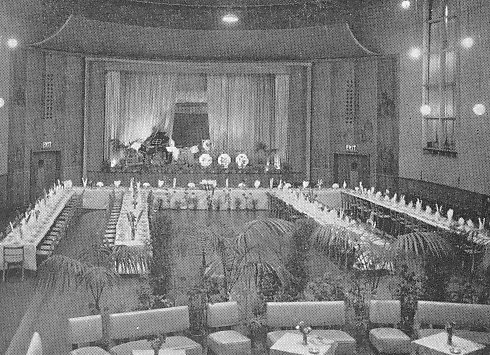
The Wulfrun Hall, as preparations are
made for a dinner. |
The official opening took place on Thursday 12th May,
1938.
The proceedings began at 11.30 when Mr. G. D. Cunningham
the city organist of Birmingham gave a recital on the
Compton Organ while the audience arrived.
He was the first musician to play in the new building.
At 12.10 the official procession arrived. |
|
The following people took part in the
official procession:
|
| The Chief Constable |
The Mayor, Councillor R. E. Probert |
| The Town Clerk, J.
Brock Allon |
The Chairman of the
Civic Hall Committee, Councillor Bertram Kidson |
| The Earl of Dartmouth |
The Deputy Mayor, Alderman Charles
A. Mander |
| The Mayor’s Chaplain, Canon J.
Brierley |
The High Sheriff, Major S. J.
Thompson |
| The Bishop of Lichfield |
Sir Robert Bird, M.P. |
| Geoffrey le M. Mander, M.P. |
Ian Hannah, M.P. |
| The Borough Coroner, C. O. Langley |
The Stipediary Magistrate, Bertram
Grimley |
| The Lord Mayor of
Birmingham, Councillor E. R. Canning |
The Chairman of
Staffordshire County Council, Alderman R. G.
Patterson |
| The Mayors and Town
Clerks of Walsall, Dudley, West Bromwich, Smethwick,
Stafford, Wednesbury, Bilston, and Rowley Regis |
The Civic Hall
Committee |
| The Architects, E.D. Lyons and L.
Israel |
The Builders, H. B. Wilcock, and F.
Stephens |
|
| The procession proceeded through the hall to the
platform where speeches were given, prayers were said, hymns
were sung, and Lord Dartmouth declared the building open for
public use. This was followed by a short recital given by the
Wolverhampton Musical Society, conducted by Harold Gray and
accompanied by G. D. Cunningham on the organ.
Afterwards the civic party departed and the audience left
the building.
In the evening, a ball attended by all of the civic
dignitaries was held to celebrate the opening.
The guests were entertained by Jack Hylton and his
orchestra. |
 |
|
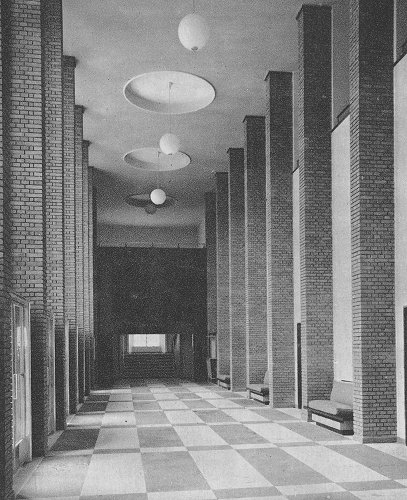
The vestibule. |
The first concert in the hall took
place four days later. It was given by the Old Royals
Association (old pupils of the Royal Wolverhampton School)
and featured Webster Booth and Ann Ziegler as soloists.
The first orchestral concert in the
Civic Hall was appropriately given by the Wolverhampton
Philharmonic, conducted by John Matthews.
They gave three concerts in the hall in
1938 and two in 1939, but sadly to small audiences, which
resulted in the disbanding of the orchestra.
In the 1940s the hall became well known
in the concert world because many of the country’s leading
orchestras played there, mainly to get away from the London
blitz.
As a result, audiences grew larger, and
the venue became greatly appreciated and successful.
|
| Between 1940 and 1945 concerts were given by the London
Philharmonic Orchestra, the Liverpool Philharmonic
Orchestra, the Hallé Orchestra, the London Symphony
Orchestra, the National Symphony Orchestra, the City of
Birmingham Orchestra, the Glasgow Orpheus Choir, and the BBC
Men’s Chorus.
Conductors included Sir Thomas Beecham, Sir Henry Wood,
Sir Adrian Bolt, John Barbirolli, Malcolm Sargent, and
Albert Coates.
There was also a Shakespearean season in the Wulfrun
Hall, given by Donald Wolfit and his company. |

A corner of the balcony. |
|

The balcony promenade. |
For a time, concerts were planned by the Music Advisory
Committee, set up by the Civic Hall Committee, and
consisting of local music lovers who made recommendations
about the number of concerts, who should give them, and who
should appear in them.
The committee tried to ensure that concert-goers would
hear as wide a range of the best music and artists as
possible, but their recommendations were not always
followed.
In June 1943 the Civic Hall Committee decided to let
visiting orchestras hire the hall, and take all of the
profits, rather than engaging orchestras.
So there was no further use for the Music Advisory
Committee, which was disbanded. |
| At the time, seat prices varied from six shillings to
two shillings and six pence. Assuming the Civic Hall was
full, the takings amounted to just under four hundred
pounds, which was about the same as the cost of engaging an
orchestra, and paying for advertising etc.
So at the time it was not very profitable. |
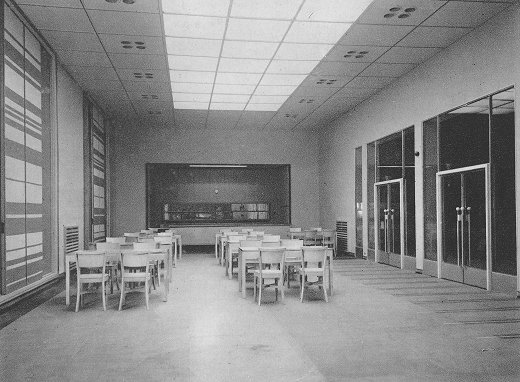
The refreshment room which is served
by lifts from the kitchens below. |
|
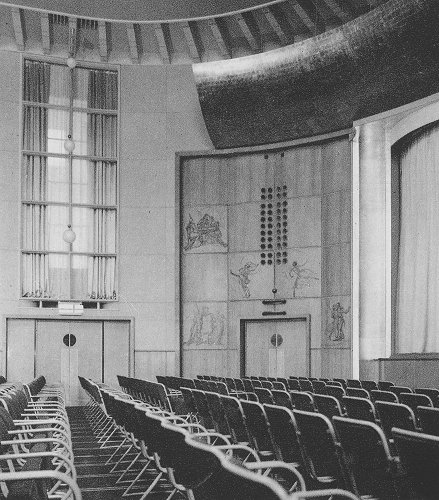
Another view of the Wulfrun Hall. |
The total takings in the Wulfrun Hall were one hundred
and five pounds, so many concerts ran at a loss.
At the same time the council was still paying off the
debt from the original loan.
Many ratepayers complained, but as the hall became more
successful, and the debt was paid-off, people came to
realise what a wonderful amenity it was. |
| A later view of the Civic Hall
with Corporation Street on the left. |
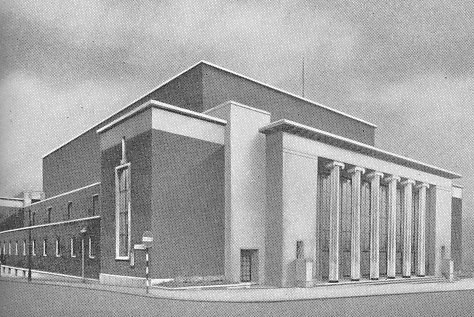 |
|
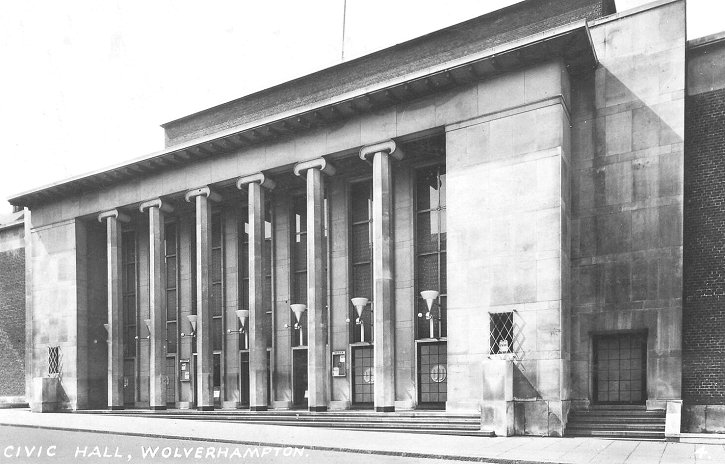
From an old postcard. |
|
Later
Years
In the 1950s and 1960s the halls became
a fashionable place for all kinds of entertainment and are now a
well known and popular venue. All kinds of events featuring
well known artists have been held, including classical music
concerts, opera, popular music, comedy, sporting events
such as boxing and wrestling, and televised darts tournaments.
There are also club nights, ballroom dancing, and the annual
Wolverhampton Beer Festival.
|
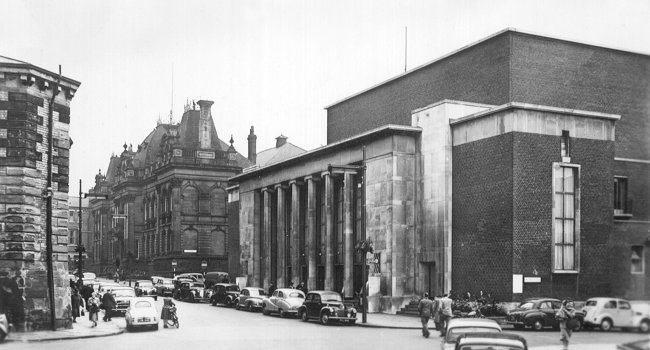
A view of the Civic Hall from a 1950s
postcard.

An advert from 1965.
|
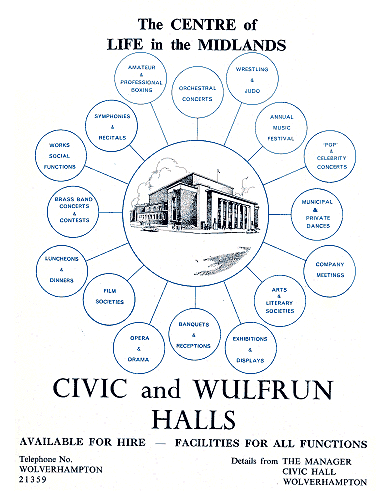
An advert from 1968. |
The Cultural and Entertainments
Committee regularly sponsored symphony concerts, plays,
dances, and the civic choir. The committee also organised a
competitive music festival, a festival of contemporary
music, and a drama festival. The Arts Society and a film
society regularly met at the Wulfrun Hall.
By the late 1960s many famous variety
stars had appeared at the Civic Hall including Danny Kaye,
Gracie Fields, Tommy Steele, Diana Dors, Johnny Ray, and Nat
King Cole. Every leading British dance band appeared
there, and many of the events were regularly broadcast on
radio and television.
A few years ago the building was
refurbished to increase the seating capacity to 3,000, and
expand the stage area. Work began on the three million pound
project in April 2000 and included the building of two new
gallery bars with frameless glazed facades, new toilets and
cloakrooms, new fire escapes and dressing rooms, bars on the
ground floor, a gallery promenade to provide easy access to
seating, and improved servicing facilities with direct
access to Corporation Street. The architects were Penoyre &
Prasad, of London.
|

A view from the early 1970s.
|
While the work was underway a new music
venue opened in 2001 in North Street at the Little Civic,
which was previously called the Town Hall Tavern. It opened
to provide a box office facility while the renovation work
was underway, and soon became an extremely popular venue for
lovers of pop music. It closed in 2009, much to the
disappointment of many people, and later reopened as the
Slade Rooms in Broad Street.
After the renovation, the Civic and
Wulfrun Halls have continued to be an extremely popular
venue for all kinds of concerts and events. The building
received a Civic Trust Award in 2004.
|
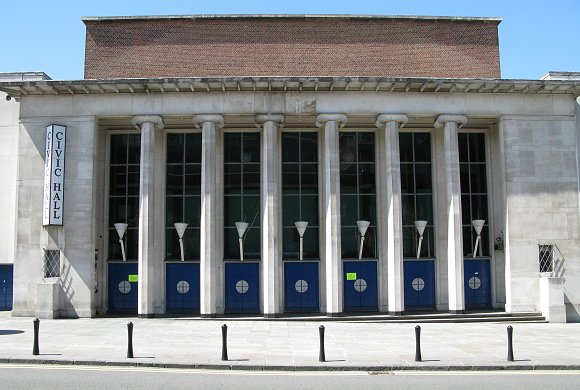
A modern view of the building.
 |
Return to
the
previous page |
|